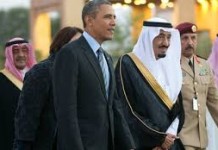Although President Obama had initially pushed for a negotiated approach towards Iran, it is becoming more evident with the passage of time that without the threat of military action, talks are not going to materialize. The President has to rely on the use of strength as well as diplomacy. Anything that looks like weakness can potentially be exploited by adversaries throughout the world. Vice President Biden’s statement that Israel, as a sovereign state, is free to make its own decisions regarding Iran, appears to be giving a green light for Israel to act. The main thrust behind US policy is to not to encourage Israel to act independently vis-a-vis Iran, but in cooperation with other nations.
All of this is happening against the backdrop of the September deadline set by G8 for Iran to show that it will cooperate on the matter of its nuclear program.
Analysis
The United States and Israel see an opening in the post-election Iranian instability and are thus changing their approach towards that nation. America and Israel have temporarily put aside their differences on the settlement issue and focused on Iran as their common priority. Israel has shown great concern regarding Iran’s nuclear ambitions, as well as about threats from Hezbollah on Israel’s northern border and support for Hamas in the Gaza Strip. The United States, on its part, worries that Iran, supported by Russia, is hindering its plans not only in the Middle East but in Afghanistan.
The Israeli media has suggested that dealing with the Iranian threat is also a priority for the Arabs, higher than that of the longstanding Israeli-Palestinian Conflict. It does appear, in fact, that the Sunni Arabs generally and particularly the Saudis, Egyptians and Jordanians are apprehensive regarding Iranian intentions in the region. At the same time, complicating the peace talks, Saudi Arabia and Jordan have claimed that any movement on negotiations with Israel would have to, at the outset, address the final-status issues of the future Palestinian state and the control of Jerusalem, return of Palestinian refugees and the resolution of water and security matters.
There are a number of recent military indicators suggesting preparations for a hard-line approach against Iran: (1), last September the United States supplied Israel with a powerful long-range early warning radar system to protect against a potential Iranian missile attack, which is designed to work in sync with the Israeli Arrow II ballistic shield; (2), this summer, the Israeli Air Force (IAF) placed an order for 100 Laser Guided Joint Direct Attacks Munitions (LJDAMS). These are designed to be mounted on either an aircraft or used by ground troops, against moving targets; (3), in July, the Air Forces of Israel, the US and the UK practiced long-range attacks as part of the Red Flag exercise at the Nellis Air Force Base in Nevada; (4), in the same month, Israeli submarines and ships conducted maneuvers through the Suez Canal into the Red Sea; and (5),the reports of the US Air Force increasing its emphasis on Massive Ordinance Penetrator (MOP), the next generation of bunker-buster, designed to take out hardened and deeply buried targets.
To counter these moves, Russia has been thinking of providing Iran with the S-300, claimed to be the best of the most advanced multi-target anti-aircraft-missile systems in the world today. Russia has also continued to support the Iranian Bushehr nuclear facility and has reportedly begun to reestablish and modernize the Soviet-era naval maintenance base near Tartus in Syria. This will enable Russia to operate in the four seas: The Atlantic, Indian, Mediterranean and Red; thus Syria’s importance to both Moscow and the United States has increased. This has been followed by recent naval exercises on the part of Iran and Russia in the Caspian Sea.
It is essential to point out, however, that Russia’s main objective is to convince the United States that it still has the power to seriously damage American interests, if America continues with implementing the Ballistic Missile Defense system and in assisting NATO expansion in Russia’s Near Abroad.
In the developing Iran crisis, the critical factor is the extent to which Israel will hold off, which in turn depends on how comfortable the country feels with assurances regarding Iranian nuclear ambitions. The internal divisions created by the Iranian election crisis has provided a window of opportunity which will not remain open forever: for the United States and its allies to exert enough pressure on Iran to make it change its behavior, without having to go to war.
The next six to nine months are critical. The Iran crisis has the potential to set off the most dangerous conflict facing the world, with direct implications for the conflicts and tussles in Iraq, Lebanon, Palestine, Afghanistan, as well as for the situation in FATA and the Baluchistan province of Pakistan. Baluchistan is emerging as a place where increasingly the local grievances are getting mixed up with struggles of the global and regional powers, impacting Pakistan, Iran and Afghanistan most directly.
Tell Us What You Think



